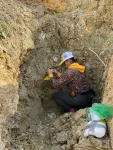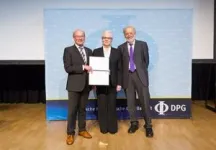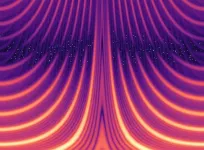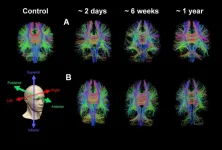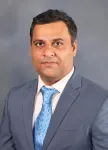(Press-News.org) LOGAN, UTAH, USA -- Utah State University geoscientist Alexis Ault recalls the devastating aftermath of back-to-back 7.8 and 7.6-magnitude earthquakes on Feb. 6, 2023, near the Turkey-Syria border that killed more than 50,000 people and displaced millions.
“We witnessed the destruction firsthand, as well as the resilience of the country and population trying to get their footing and rebuild,” says Ault, associate professor in USU’s Department of Geosciences, who traveled to the disaster site about six months after the catastrophic quakes. “It was heartbreaking, but also inspiring.”
Unfortunately, she says, Turkey is among many countries that repeatedly experience large and damaging earthquakes on an unpredictable basis. Her colleague Brady Cox, founding director of USU’s Earthquake Engineering Research Center, has also observed calamitous human suffering and infrastructure damage during the past 25 years following earthquakes in the United States and abroad. Citizens of Utah, says Cox, professor in USU’s Department of Civil and Environmental Engineering, are also at risk from a significant — and potentially overdue — earthquake along the Wasatch Fault.
Understanding the earthquake cycle processes that portend such powerful forces and how to mitigate their risk is at the core of a research project Ault is undertaking with Cox and USU Geosciences colleagues Dennis Newell and Srisharan Shreedharn, along with Brown University geophysicist Greg Hirth and California State University, Fullerton geologist Sinan Akçiz. The team was awarded a $2.3 million Frontier Research in Earth Sciences (FRES) grant from the U.S. National Science Foundation to pursue the five-year project.
Ault, Newell and Akçiz’s trip to the 2023 7.6-magnitude quake site, funded by an NSF Rapid Response Research grant, enabled them to collect fragile samples from the earthquake’s rupture interface along the Çardak-Yesilyurt Fault system, along with measuring gas flux along the rupture.
“Those delicate samples, which are no longer possible to acquire because the rupture interface erodes with time, provide critical materials for the current study,” says Newell, professor and interim head of USU’s Department of Geosciences.
The Çardak-Yesilyurt rupture samples, along with samples and shallow geophysical data the researchers have collected from California’s southern San Andreas fault, will help the team investigate how the earthquake critical zone — the near-surface layer of the Earth’s restless crust — accumulates and releases earthquake energy on major strike-slip faults. Ault notes acquisition of geophysical data across the San Andreas fault, led by Cox, was made possible by USU faculty Seed Grants awarded to Ault and Cox.
Ault says, unlike the fault in Turkey, the San Andreas fault is overdue for an earthquake.
“This NSF-funded project will help us overcome limitations of previous, generalized characterizations of earthquake critical zones with more in-depth geologic data, seismic imaging studies, deformation experiments and modeling,” she says. “Combining expertise from varied engineering and geoscience disciplines, we aim to emerge with a more complete and accurate picture of earthquake critical zones in these settings.”
The team plans to leverage NSF-supported, shared-use equipment and data archiving resources from the Natural Hazards Engineering Research Infrastructure (NHERI) program and USU’s new Rock Deformation and Earthquake Mechanics Lab, the latter of which is led by co-PI Shreedharan.
“By deforming these one-of-a-kind samples in the Rock Deformation and Earthquake Mechanics Lab under the same pressures that they experienced in the near-surface crust, we can begin to understand how, where and over what timescales strike-slip fault zones like the San Andreas and Çardak-Yesilyurt accumulate strain energy,” he says.
Centered on concepts of intellectual, educational and cultural reciprocity, the project involves international collaboration with researchers in Turkey. It also affords substantial learning and training opportunities for mentees. These include positions for three doctoral students and two postdoctoral fellows at Utah State, a doctoral student and postdoctoral fellow at Brown, and a master’s student position at CSUF, as well as multiple research opportunities for undergraduate researchers at each of the participating institutions.
In addition, the grant bolsters the USU team’s ongoing efforts with the university’s Native American Summer Mentorship Program, which encourages Aggie undergrads at the USU Blanding campus to pursue research and four-year degree programs.
“This project has the potential to benefit communities from multiple angles, including improving earthquake hazard models and seismic site response analyses to better protect human life, to providing meaningful educational opportunities in Earth sciences and engineering, as well as strengthening international partnerships,” Ault says.
END
Strike Force: Utah State leads collaborative $2.3M NSF grant to study earthquake critical zones
USU researchers Alexis Ault, Dennis Newell, Srisharan Shreedharan and Brady Cox secure five-year FRES grant
2024-08-09
ELSE PRESS RELEASES FROM THIS DATE:
Achieving quantum memory in the hard X-ray range
2024-08-09
Light is an excellent carrier of information used not only for classical communication technologies but also increasingly for quantum applications such as quantum networking and computing. However, processing light signals is far more complex, compared to working with common electronic signals.
An international team of researchers including Dr. Olga Kocharovskaya, a distinguished professor in the Department of Physics and Astronomy at Texas A&M University, has demonstrated a novel way of storing and releasing X-ray pulses at the single photon level — a concept first ...
Study shows donor kidneys with toxoplasma do not increase risks for transplant patients
2024-08-09
A new study from UC Davis Health could help to increase the supply of donor kidneys.
Researchers have found that transplant patients who receive kidneys infected with the parasite toxoplasma have virtually the same outcomes as those who receive toxoplasma-negative organs.
Despite longstanding concerns, those who received kidneys from toxoplasma antibody positive donors (TPDs) had almost identical mortality and rejection rates. The research was published in Transplant International.
“Organs from donors who were positive for toxoplasma did ...
Advanced MRI scans help identify one in three concussion patients with ‘hidden disease’
2024-08-09
Offering patients with concussion a type of brain scan known as diffusion tensor imaging MRI could help identify the one in three people who will experience persistent symptoms that can be life changing, say Cambridge researchers.
Around one in 200 people in Europe every year will suffer concussion. In the UK, more than 1 million people attend Emergency Departments annually with a recent head injury. It is the most common form of brain injury worldwide.
When a patient in the UK presents at an Emergency Department with head injury, they ...
Psychological bias links good deeds to a belief in God, research says
2024-08-09
Experiments conducted by UC Merced researchers find that people who perform good deeds are far more likely to be thought of as religious believers than atheists. Moreover, the psychological bias linking kindness and helpfulness with faith appears to be global in scale.
Research on the mental link between moral behavior and religious belief goes back more than a decade. Prior research, however, emphasized the dark side of this equation, with participants asked whether they assumed it was more probable that a serial killer believed in God or was an atheist (people in nations all over the planet thought the latter ...
Greenland megatsunami led to week-long oscillating fjord wave
2024-08-09
In September 2023, a megatsunami in remote eastern Greenland sent seismic waves around the world, piquing the interest of the global research community.
The event created a week-long oscillating wave in Dickson Fjord, according to a new report in The Seismic Record.
Angela Carrillo-Ponce of GFZ German Research Centre for Geoscience and her colleagues identified two distinct signals in the seismic data from the event: one high-energy signal caused by the massive rockslide that generated the tsunami, and one very long-period (VLP) signal that lasted over a week.
Their analysis of the VLP signal—which was detected as far as 5000 kilometers away—suggests ...
Machine learning approach helps researchers design better gene-delivery vehicles for gene therapy
2024-08-08
Gene therapy could potentially cure genetic diseases but it remains a challenge to package and deliver new genes to specific cells safely and effectively. Existing methods of engineering one of the most commonly used gene-delivery vehicles, adeno-associated viruses (AAV), are often slow and inefficient.
Now, researchers at the Broad Institute of MIT and Harvard have developed a machine-learning approach that promises to speed up AAV engineering for gene therapy. The tool helps researchers engineer the protein shells of AAVs, called capsids, to have multiple desirable ...
Bacteria encode hidden genes outside their genome—do we?
2024-08-08
NEW YORK, NY (Aug. 8, 2024) -- Since the genetic code was first deciphered in the 1960s, our genes seemed like an open book. By reading and decoding our chromosomes as linear strings of letters, like sentences in a novel, we can identify the genes in our genome and learn why changes in a gene’s code affect health.
This linear rule of life was thought to govern all forms of life—from humans down to bacteria.
But a new study by Columbia researchers shows that bacteria break that rule and can create free-floating and ephemeral genes, raising the possibility that similar genes exist outside ...
Assistant professor's $1.1M NASA grant to develop computational tool aiding hypersonic vehicle design
2024-08-08
STARKVILLE, Miss.—NASA is awarding a Mississippi State University assistant professor a $1.13 million grant to develop a new simulation tool to aid the design of hypersonic vehicles used in space exploration.
Vilas Shinde of MSU’s Department of Aerospace Engineering won the grant to develop a new flow stability and transition analysis tool, which will aid researchers and aircraft designers in understanding and predicting changes associated with the boundary layer—air flow in the vicinity of an aircraft’s ...
Houston Methodist study shows new, more precise way to deliver medicine to the brain
2024-08-08
Houston Methodist researchers have discovered a more accurate and timely way to deliver life-saving drug therapies to the brain, laying the groundwork for more effective treatment of brain tumors and other neurological diseases.
In a study published this month in Communications Biology, an open access journal from Nature Portfolio, investigators used an electric field to infuse medicine from a reservoir outside the brain to specific targets inside the brain. This adds a new dimension to the 30-year-old process of injecting therapeutics into the brain through ...
A ‘thank you’ goes a long way in family relationships
2024-08-08
URBANA, Ill. – You’ve probably heard that cultivating gratitude can boost your happiness. But in marriage and families, it’s not just about being more grateful for your loved ones — it’s also important to feel appreciated by them. Researchers at the University of Illinois Urbana-Champaign have previously explored the positive impact of perceived gratitude from romantic partners for couples’ relationship quality. In a new study, they show the benefits of perceived gratitude ...
LAST 30 PRESS RELEASES:
Red light therapy shows promise for protecting football players’ brains
Trees — not grass and other greenery — associated with lower heart disease risk in cities
Chemical Insights scientist receives Achievement Award from the Society of Toxicology
Breakthrough organic crystalline material repairs itself in extreme cold temperatures, unlocking new possibilities for space and deep-sea technologies
Scientists discover novel immune ‘traffic controller’ hijacked by virus
When tropical oceans were oxygen oases
Positive interactions dominate among marine microbes, six-year study reveals
Safeguarding the Winter Olympics-Paralympics against climate change
Most would recommend RSV immunizations for older and pregnant people
Donated blood has a shelf life. A new test tracks how it's aging
Stroke during pregnancy, postpartum associated with more illness, job status later
American Meteorological Society announces new executive director
People with “binge-watching addiction” are more likely to be lonely
Wild potato follows a path to domestication in the American Southwest
General climate advocacy ad campaign received more public engagement compared to more-tailored ad campaign promoting sustainable fashion
Medical LLMs may show real-world potential in identifying individuals with major depressive disorder using WhatsApp voice note recordings
Early translational study supports the role of high-dose inhaled nitric oxide as a potential antimicrobial therapy
AI can predict preemies’ path, Stanford Medicine-led study shows
A wild potato that changed the story of agriculture in the American Southwest
Cancer’s super-enhancers may set the map for DNA breaks and repair: A key clue to why tumors become aggressive and genetically unstable
Prehistoric tool made from elephant bone is the oldest discovered in Europe
Mineralized dental plaque from the Iron Age provides insight into the diet of the Scythians
Salty facts: takeaways have more salt than labels claim
When scientists build nanoscale architecture to solve textile and pharmaceutical industry challenges
Massive cloud with metallic winds discovered orbiting mystery object
Old diseases return as settlement pushes into the Amazon rainforest
Takeaways are used to reward and console – study
Velocity gradients key to explaining large-scale magnetic field structure
Bird retinas function without oxygen – solving a centuries-old biological mystery
Pregnancy- and abortion-related mortality in the US, 2018-2021
[Press-News.org] Strike Force: Utah State leads collaborative $2.3M NSF grant to study earthquake critical zonesUSU researchers Alexis Ault, Dennis Newell, Srisharan Shreedharan and Brady Cox secure five-year FRES grant
